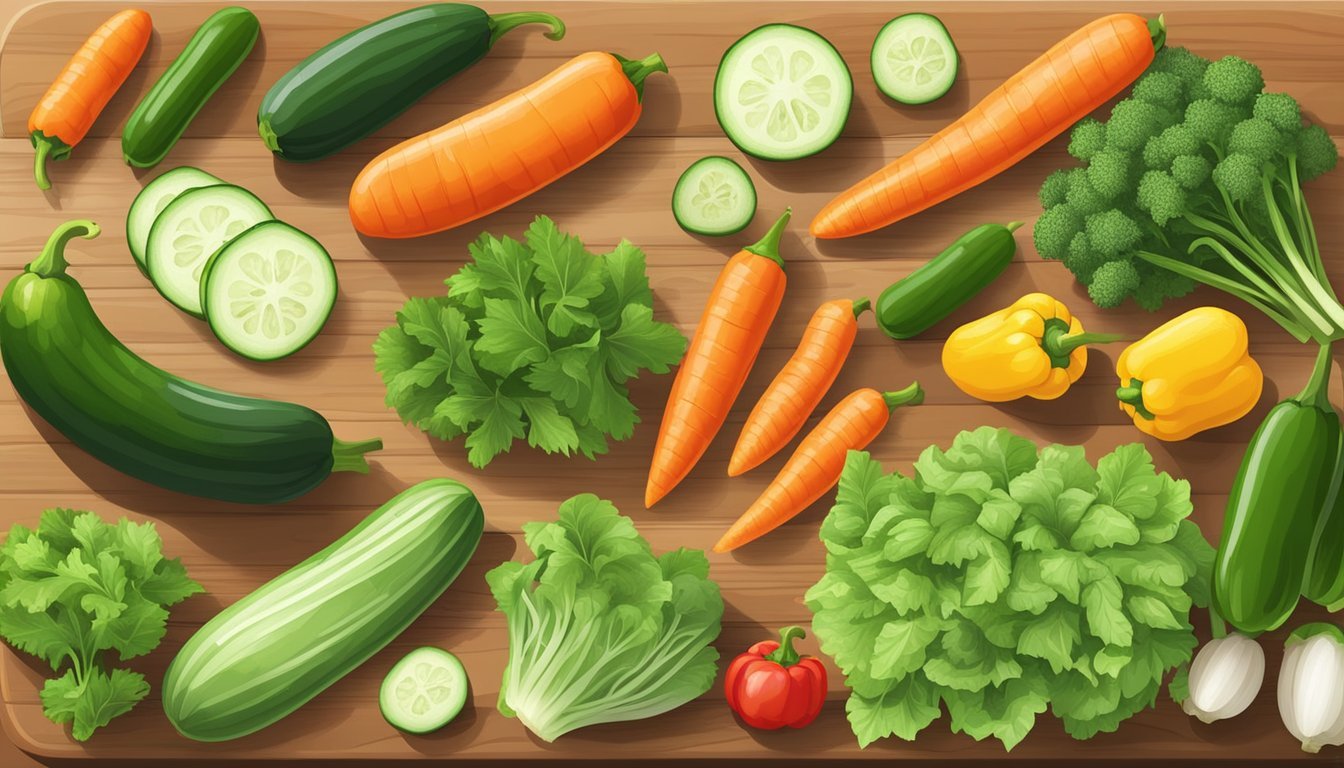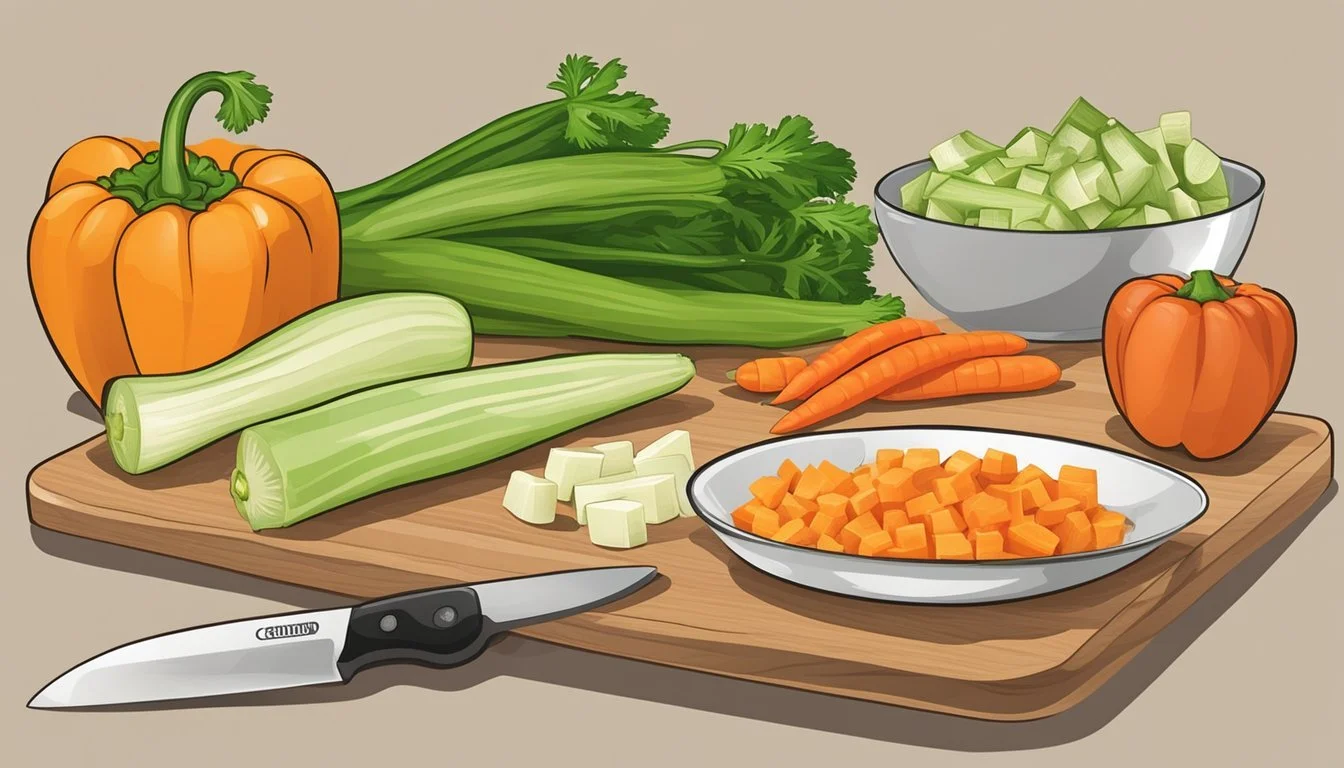Celery Substitutes
Top Alternatives for Flavor and Crunch
Finding the perfect substitute for celery can be essential for those who may have dietary restrictions, allergies, or simply prefer a different flavor profile. Fennel often tops the list as it has a similar texture and, when cooked, mimics the milder taste of celery. This makes it a versatile option for soups, stews, and other cooked dishes. Another noteworthy alternative is celeriac, also known as celery root, which offers a unique texture and a closely related flavor to celery.
For those looking for substitutes in raw dishes or salads, options like bok choy and cucumbers can be highly effective. Bok choy provides a satisfying crunch and is rich in nutrients like Vitamin A and Vitamin C. Cucumbers, with their refreshing crispiness, can also be a great addition to any salad or cold dish, offering a slightly different but enjoyable texture.
Water chestnuts, jicama, and radishes are other excellent options, especially when a crunchy texture is desired. Water chestnuts and jicama have a slightly sweet flavor and are commonly used in stir-fries, while radishes bring a peppery bite that can enhance various recipes. Whether you're dealing with allergies or simply looking to try something new, these substitutes can ensure your meals stay flavorful and enjoyable.
Understanding Celery
Celery's unique texture and flavor make it a versatile ingredient in a variety of culinary applications. It brings nutritional benefits and a distinctive crunch to dishes ranging from soups to salads.
Nutritional Profile of Celery
Celery is low in calories but rich in essential nutrients. A medium stalk typically contains about 6 calories, supporting weight management goals. It is an excellent source of vitamin K, important for blood clotting and bone health.
The fiber content aids in digestion and helps maintain a healthy gut. Celery also provides potassium, which helps regulate blood pressure, and vitamin A for eye health. Additionally, it contains folate, which is essential for DNA synthesis and repair.
Common Uses in Cooking
Celery is widely used in cooking for its crunchy texture and slightly peppery flavor. It is a standard component of mirepoix, a flavor base in French cuisine, usually paired with onions and carrots. This combination is fundamental in soups and stews.
In making stuffing, celery adds both flavor and a pleasant crunch. It’s also a popular ingredient in green juices, providing a refreshing taste. Sliced celery is often added to salads for its crunch and subtle flavor enhancement.
The Role of Celery in Recipes
Celery plays a crucial role in recipes by enhancing both texture and flavor. In soups and stews, it provides a savory depth that enriches the broth. Celery's crunch can balance the texture in otherwise soft dishes.
When used in stew and mirepoix, it acts as a supporting player that ties other flavors together. In stuffing, celery's fibrous texture contrasts well with softer ingredients. It is also a popular addition to flavor bases, helping to create a savory undertone in various recipes.
Celery Substitute Basics
When choosing a celery substitute, considerations include texture, flavor, and water content. These factors ensure that the chosen ingredient blends well with the dish, maintaining the original recipe's intended taste and mouthfeel.
Criteria for Choosing a Celery Substitute
The main criteria for selecting a celery substitute revolve around texture, flavor, and water content. Celery's crisp texture and mild, slightly peppery flavor make it unique in many culinary applications. Substitutes should mimic these qualities as closely as possible.
Crunch is a key attribute. Options like jicama and water chestnuts maintain a crisp texture, making them suitable for salads and raw applications.
Flavor also plays a significant role. Ingredients such as fennel and celeriac can provide a similar mild flavor, though fennel is slightly more aromatic and has a hint of anise.
Water content is another crucial factor, as celery has high water content that impacts the consistency of soups and stews. Substitutes like cucumbers or bok choy can match this hydration level, ensuring proper texture in cooked dishes.
Importance of Texture and Flavor
Texture significantly affects the eating experience, particularly in salads and raw dishes. Celery's characteristic crunch can be replicated with ingredients like green apple or carrot, which offer a refreshing bite.
Flavor must also be considered to avoid overpowering the dish. Celery adds a subtle, refreshing taste that balances other ingredients. Alternatives such as bok choy provide a light, slightly nutty flavor that can complement many recipes without dominating the palate.
Cooking methods also influence texture and flavor. For example, carrots and onions soften when cooked, integrating well into soups and stews while maintaining a complementary flavor profile.
Using substitutes that maintain a balance between texture, flavor, and water content ensures the integrity of the original dish remains intact. This careful selection helps achieve a seamless culinary substitution that satisfies both the cook and the diner.
Vegetable Substitutes for Celery
Various vegetables can replace celery, whether you're looking for a similar crunch, leafy greens, or aromatic options for cooking. These substitutes can add the needed texture and flavor to your dishes.
Crunchy Vegetable Alternatives
Fennel has a similar texture to celery but comes with a stronger taste. When cooked, its flavor mellows, making it suitable for soups and stews.
Carrots provide a crunchy texture and slight sweetness. They can be used in a mix with onions to substitute for celery in many cooked dishes.
Water chestnuts offer a crunchy texture with a mildly sweet flavor. This makes them ideal for stir-fries and salads.
Jicama adds a crisp texture and subtle sweetness, making it a good replacement in raw dishes like salads.
Vegetable Texture Flavor Fennel Crunchy Strong, anise-like Carrots Crunchy Sweet Water chestnuts Crunchy Mildly sweet Jicama Crunchy Mild, slightly sweet
Leafy Green Substitutes
Spinach can replace celery in soups and stews, providing a different texture but still adding volume.
Lettuce varieties like romaine can add crunch to salads in place of celery.
Kale offers a robust texture and slightly bitter flavor, suitable for cooked dishes.
Bok choy and Chinese cabbage provide crunch in stir-fries and soups, with a flavor that blends well in cooked dishes.
Aromatic Substitutes for Cooking
Onions can stand in for celery in many recipes, adding a savory depth.
Green onions provide a milder, more subtle flavor and work well in salads and garnishes.
Garlic and shallots offer strong aromatic qualities, enhancing soups, stews, and other cooked dishes.
Using these substitutes can ensure your dish retains its intended flavor and texture profile.
Fruit-Based Celery Alternatives
For those who desire a celery substitute that offers a similar crunch and refreshing taste, certain fruits can be an excellent choice. These alternatives can enhance your dishes with unique flavors and textures.
Sweet Substitutes with Crunch
Apples are an excellent option. They provide a satisfying crunch and a touch of sweetness. Varieties like green apples offer a tartness that can balance savory dishes. Use them in salads or slaws for an added texture.
Jicama is another great alternative. Though it is not as sweet as apples, its mild sweetness and crunchy texture make it suitable for both raw and cooked recipes. It can be diced into salads or sliced for a crisp snack.
Pears, with their subtle sweetness and slightly grainy texture, can also be used. They work well in salads or as a complement to cheeses and nuts, adding a depth of flavor and a fruity crunch.
Refreshing Choices for Salads
Cucumbers bring a fresh, mild flavor to dishes. They can substitute celery in green salads or cold pasta dishes, providing a refreshing bite. Use English cucumbers for fewer seeds and a smoother texture.
Bell Peppers offer a crisp texture and sweet flavor without the bitterness of celery. They come in various colors, adding a visual appeal to salads. Red and yellow bell peppers are particularly sweet and can enhance your dish's taste profile.
Radishes provide a peppery crunch that can invigorate salads. They are especially helpful in adding a bit of zing. Slice them thinly to mix them with leafy greens or other vegetables for a colorful, crunchy component.
Herbs and Spices as Celery Replacements
Herbs and spices can provide robust flavors and aromatic qualities reminiscent of celery. These alternatives are perfect for those who wish to replicate the distinct taste of celery in various dishes.
Using Seeds for a Celery Flavor
Celery seed offers a concentrated, slightly bitter taste that can stand in for fresh celery in many dishes. It’s often used in soups, stews, and dressings for its potent flavor. For an equivalent flavor substitution, start with a small amount and adjust to taste.
Dill seeds bring a mild, somewhat tangy flavor that can also replace celery. These seeds work well in pickling, soups, and savory bakes. Due to their delicate taste, they are best added towards the end of the cooking process to maintain their aromatic properties.
Fennel seeds introduce a mild, sweet flavor, somewhat akin to celery with a touch of licorice. They are ideal for use in both sweet and savory dishes. Fennel seeds can be ground or used whole, and they pair well with meat, vegetables, and even breads.
Fresh Herbs with Similar Aromas
Parsley offers a bright, slightly peppery flavor that closely mimics the freshness of celery. This herb is versatile and can be used in salads, soups, and as a garnish. Use chopped parsley as a 1:1 substitute for celery to maintain a comparable taste.
Cilantro provides a citrusy, fresh aroma, which can substitute celery in certain dishes. It works especially well in salsas, salads, and garnishes. Note that cilantro has a strong flavor, so start with a smaller quantity and adjust as needed.
Celery leaves themselves can be used as a substitute for the stalks. They carry the same flavor profile and can be used in soups, stews, and as garnishes. Just chop finely and use as a 1:1 substitute to maintain the celery taste without the crunch.
Considerations When Replacing Celery
Replacing celery in recipes requires attention to both dietary restrictions and flavor balance. It's essential to choose substitutes that not only mimic celery's texture and crunch but also complement the dish's overall taste profile.
Allergic Concerns and Dietary Restrictions
When selecting a celery substitute, it's important to consider allergies and dietary restrictions. Some common alternatives, such as bell peppers, water chestnuts, and cucumbers, are generally safe for most people. However, certain individuals might have specific intolerances or allergies.
For those following a low-carb diet, options like cucumbers and green peppers are ideal substitutes as they have similar textures without adding extra carbohydrates. Additionally, substitutes like jicama provide a crunch similar to celery while being low in calories, making them suitable for calorie-conscious diets.
Flavor Balance and Recipe Adjustments
Different celery substitutes bring varied flavor profiles to dishes. Celery has a distinct, mild bitterness that can affect the recipe's taste if replaced incorrectly. For instance, green apples and fennel stalks provide a refreshing flavor but can skew slightly sweet.
To maintain the balance in taste, combining several substitutes, such as carrots and onions, can help achieve a closer flavor match to celery. When cooking with these alternatives, adjusting seasoning might be necessary to enhance or mitigate the new flavors introduced.
Substitutes like leeks and celery root (celeriac) can also provide a similar flavor profile but with a denser texture, making them more suited for cooked dishes rather than raw applications.
Purchasing and Storing Substitutes
When it comes to purchasing and storing substitutes for celery, selecting the best quality produce and maintaining their freshness are crucial. This ensures your dishes retain their flavor, texture, and nutritional value.
Tips for Buying the Best Alternatives
To find the best celery substitutes, look for vegetables that are fresh and firm. Fennel should have crisp stalks and aromatic bulbs. Celeriac must feel heavy for its size and be free of soft spots. For water chestnuts, pick those with a shiny, smooth exterior.
If you prefer bell peppers, choose ones with vibrant colors and unwrinkled skin. Leeks should have firm stalks and rich green tops. Buying these vegetables in peak season will also enhance their taste and ensure the best texture.
When shopping, try to buy organic when possible to avoid pesticide residues. Inspect produce carefully to avoid those with signs of wilting or spoilage, as this affects both taste and longevity.
Proper Storage for Freshness
Storing celery substitutes correctly is essential for maintaining their freshness. Fennel should be wrapped in a damp paper towel and stored in the refrigerator. This helps retain its moisture and crunch.
Celeriac keeps best in a cool, dry place; wrapping it in a plastic bag can help retain its firmness. Bell peppers should be kept in a perforated plastic bag in the crisper drawer of your fridge. This ensures they stay crisp and colorful.
Leeks last longest when stored unwashed in the vegetable drawer. Water chestnuts can be kept in a bowl of water in the refrigerator, changing the water daily to keep them fresh. Proper storage techniques can extend the life of these ingredients, allowing you to enjoy them at their peak flavor.






